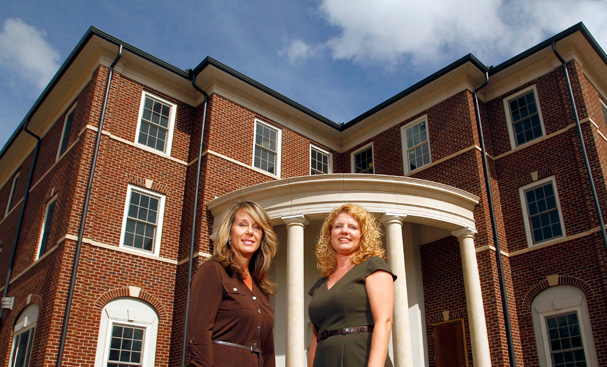By Diane Ballard
Sorority Village opens this fall in Knoxville
Sorority women at the University of Tennessee, Knoxville, have long carried a bit of a chip on their collective shoulder. Greek men have had houses on or near campus since early last century. Sororities haven’t.
But patience has paid off in a big way as sororities this fall celebrate the opening of long-awaited houses in a park-like village at the far western end of the campus. Sorority Village, bounded by Kingston Pike, Neyland Drive and Alcoa Highway, is home to 13 houses, some substantially completed and others that will be occupied in the coming months.
After almost 50 years in crowded suites in the Panhellenic Building, sororities are gaga over spacious houses that allow sisters to live and enjoy meals together.
Halie Anderson, president of Sigma Kappa, says houses will bring sorority sisters even closer.
“This experience will develop our bond even more. These houses aren’t just for the women at UT now. They’re for generations to come.”
The university owns the land, but each sorority is paying for its own house. The structures range in price from $2 million to $4.8 million. Most will sleep 30 to 50 women and include living areas, large kitchens, and meeting and study rooms. Many were designed by architects who are graduates of UT Knoxville’s College of Architecture and Design.
“The house creates a learning community. The women will have an opportunity to share a wonderful residential space while pursuing their academic goals.”In addition to the 13 houses, there is a small Panhellenic building, which also houses a nonresidential meeting space for Alpha Kappa Alpha Sorority. Campus bus service will serve the village, and security will be tight. The entire village will be secured by a fence, and there will be a gated entrance, emergency phones and security cameras. Parking will be available for residents.
The sluggish economy made fundraising for the houses challenging. Shannon Hampson (Knoxville ’87), an alumna of Kappa Delta, says she worked seven years to secure gifts for the house.
“It was difficult,” she says candidly. “Maybe at first people didn’t think it [sorority houses] would really happen.” A large gift from one alumna spurred others to give, and Kappa Delta reached its goal for its $3.9 million Federalist style house.
“I loved sorority life,” Hampson says. “I thought living in a house would be awesome, especially in a village setting. I hope this house feels like home for our women.”
The houses will undoubtedly enhance togetherness, but Emily Parker (Knoxville ’98), co-chair of the housing project for Alpha Chi Omega, says living together so closely also should benefit women academically.
“The house creates a learning community. The women will have an opportunity to share a wonderful residential space while pursuing their academic goals.” The $3.1 million Alpha Chi Omega house, constructed in the Regency style, is built to house 52 women.
The land upon which Sorority Village rests has a historic pedigree. When archaeological studies were done prior to construction, Civil War canon emplacements and trenches were discovered. Researchers say the structures mark the only archaeologically confirmed Confederate battle site in Knoxville.
For years, rumors circulated that sorority houses couldn’t be built because of an arcane state law classifying a dwelling that houses more than five unmarried women as a brothel. Not so. Then there was the rumor that a well-heeled donor gave money for the old Panhellenic Building on the condition that sorority houses would never be built. Not so. Having put to rest such enduring urban myths, sororities can enjoy their new houses even more.
The university will repurpose the Panhellenic Building, built in 1963.



